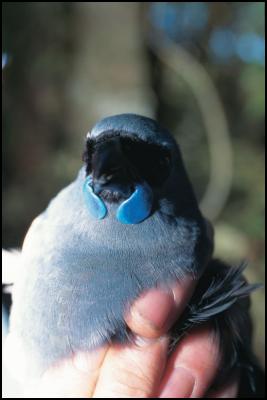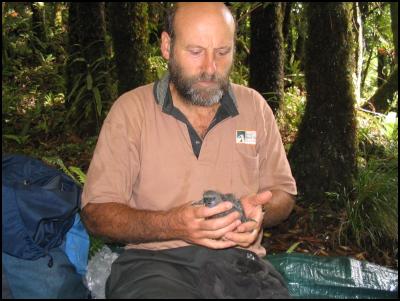Kokako population on the rise in the Hunua Ranges
Kokako population on the rise in the Hunua Ranges
13 July 2009
Continued success in the protection of a rare native bird species is being recorded in the Hunua Ranges Regional Park.

Click for big version
With around 750 pairs of kokako left in the North Island, the number of breeding pairs and young produced in the Hunua Ranges Kokako Management Area (KMA) has the potential to make a significant contribution to the future security of the species.
In 2008/09 the Hunua kokako project, managed jointly by the Auckland Regional Council (ARC) and Department of Conservation (DOC), reported 18 breeding pairs established in the managed area. Since management of the population began 15 years ago at least 58 young are known to have been produced.
“In 1994 the ARC stepped in to save a tiny population of kokako rapidly heading toward local extinction. This was outside the normal duties of a local body, however had we not intervened, this population would have become locally extinct.
“At the time there was only one breeding pair surviving in the Hunua Ranges,” says ARC Chairman Mike Lee.
“This partnership between the ARC and DOC is a vital effort in saving this treasured species from the threat of extinction – a reality for the South Island kokako, which is now assumed to be extinct.
The Hunua KMA contributes to a recovery plan for kokako in the North Island, managed by DOC. In that plan there is a long-term objective to establish a population of at least 50 pairs of kokako in the Hunua Ranges by 2020.
ARC natural heritage scientist Dr Tim Lovegrove says that this target is realistic.
“Based on the rate of increase in the number of breeding pairs in the population to date, the target of 50 pairs in the managed area by 2020 should be achievable. To ensure that this is achieved continued pest control is necessary,” says Dr Lovegrove.
Intensive pest control is undertaken on an 1100 hectare grid. This work is supervised by two experts employed by the ARC and is supported by park rangers and volunteers, who monitor the poison bait stations and traps.
Volunteers also monitor nests, birds and pest tracking tunnels. In the last year a total of 2090 volunteer hours were dedicated to the management of the Hunua kokako population by 50 volunteers.
ARC biosecurity programmes, such as possum and control, across the Hunua Ranges also contribute biodiversity gains in the KMA.
“As well as success with kokako, we have seen increases in bellbird and kaka numbers, and a thriving population of Hochstetter’s frogs in the ranges,” says Dr Lovegrove.
Mr Lee says proposed changes to the region’s southern boundary could affect this conservation programme and this does not sit well with his council.
“Not being able to guarantee the future of this programme is causing us concern.
“The ARC has made its position on the proposed Auckland Council’s southern boundary clear to the Government. If a significant part of the Hunua Ranges is carved off and entrusted to Environment Waikato this programme could be compromised,” he says.
The ARC’s submission to the Auckland Governance Legislation Select Committee also emphasised the effect that boundary changes would have on the region’s water supply.
Images Courtesy of Auckland regional Council
Auckland’s Southern Boundary Jul 09 (pdf)
Update On Kokako Conservation In The
Hunua
Ranges, 2008/09 (pdf)
ENDS



 Gordon Campbell: On bird flu, AUKUS entry fees and Cindy Lee
Gordon Campbell: On bird flu, AUKUS entry fees and Cindy Lee NZ Government: New Lab To Help Protect Key Pacific Tuna Fisheries
NZ Government: New Lab To Help Protect Key Pacific Tuna Fisheries Susan Botting - Local Democracy Reporter: Ruawai Leader Slams Kaipara Council In Battle Over $400k Property
Susan Botting - Local Democracy Reporter: Ruawai Leader Slams Kaipara Council In Battle Over $400k Property Te Pati Maori: Another ‘Stolen Generation’ Enabled By Court Ruling On Waitangi Tribunal Summons
Te Pati Maori: Another ‘Stolen Generation’ Enabled By Court Ruling On Waitangi Tribunal Summons Peace Action Wellington: Die In for Palestine Marks ANZAC day
Peace Action Wellington: Die In for Palestine Marks ANZAC day Labour Party: Penny Drops – But What About Seymour And Peters?
Labour Party: Penny Drops – But What About Seymour And Peters? Government: PM Announces Changes To Portfolios
Government: PM Announces Changes To Portfolios


